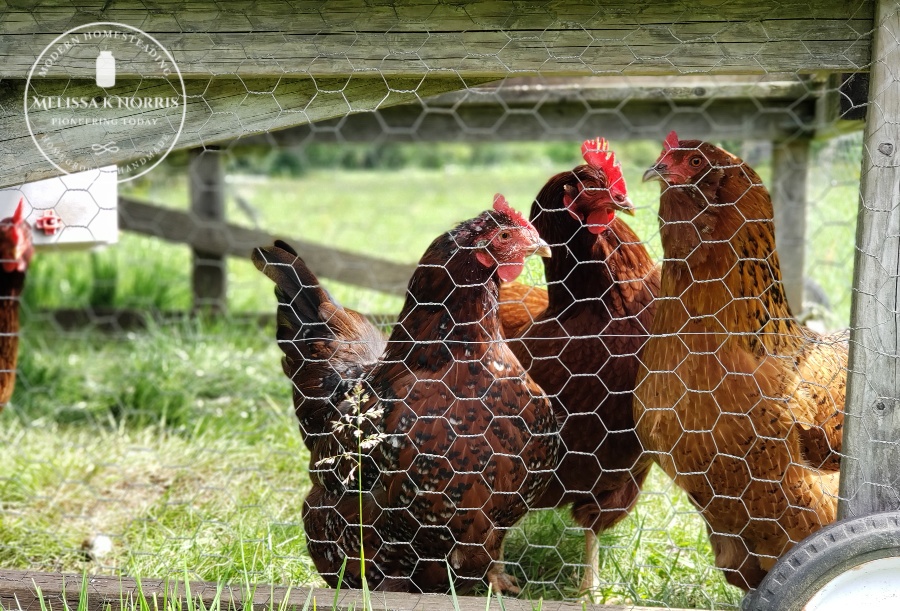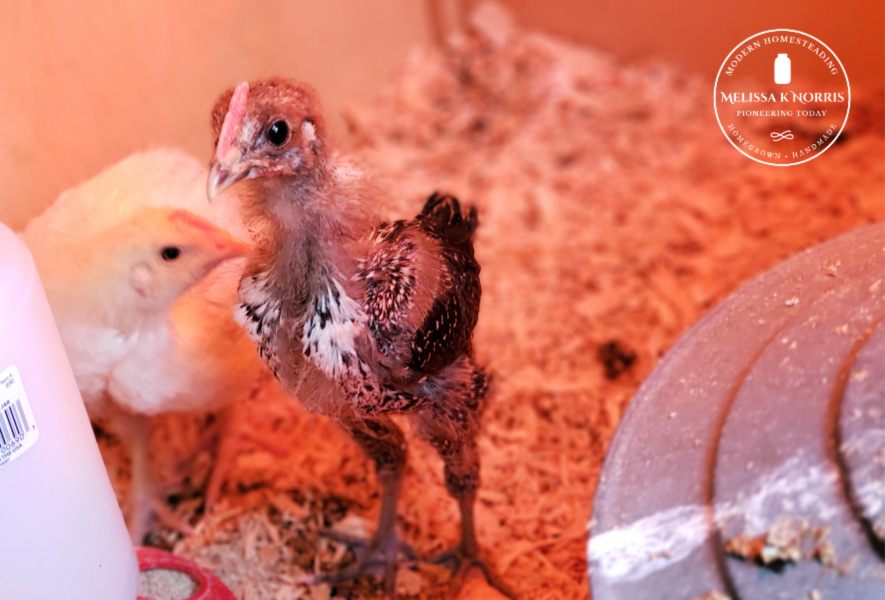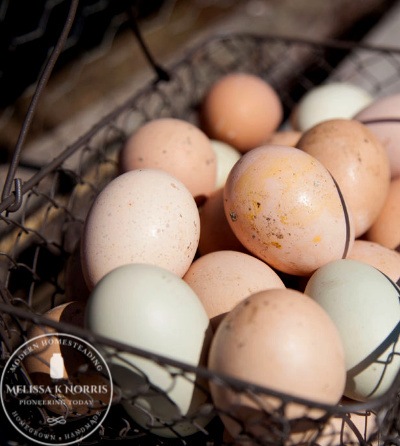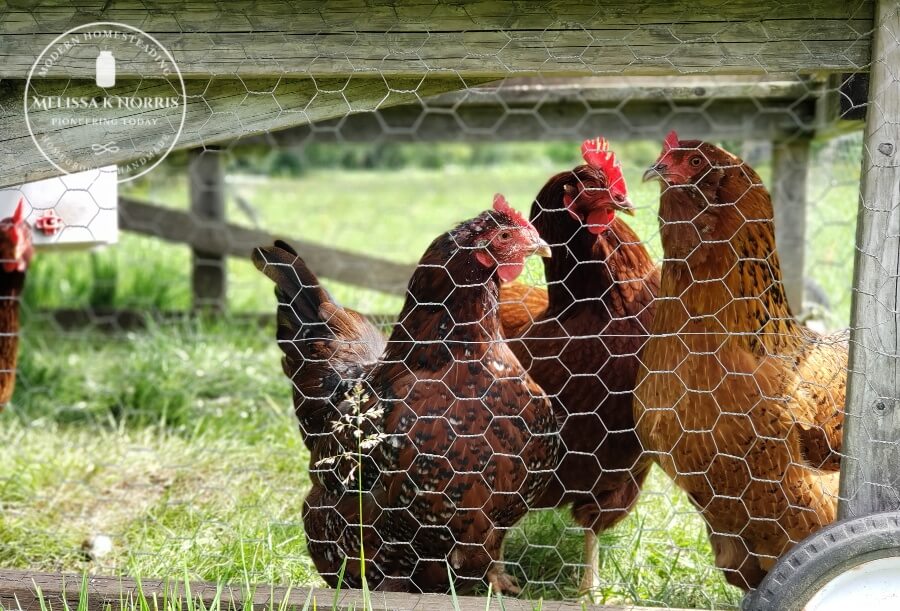Chickens are so rewarding but they can be surprisingly aggressive with one another and integrating flocks needs to be done with some care. I’ve gotten lots of questions on integrating your new chicks into existing flocks and if you should keep meat birds with your laying hens. Read on my friend for all these answers more!

Many of you are or will be raising your own chickens this year as a form of food, whether that’s meat birds or laying hens. In podcast episode #256 I covered 10 Tips on Raising Chickens for Meat and from that I had several questions come in related to how to handle dual-purpose breeds, what to do with your flocks, especially if you plan to use some for meat and some for eggs.
I also have an episode where I cover raising baby chicks in the first six weeks but many of you wanted to know what to do after those six weeks. We’ll be covering that and more in this episode.
Listen in below to the full podcast, Episode #259 Integrating New Chicks to Existing Flocks Q&A Chicken Raising, of the Pioneering Today Podcast, where we don’t just inspire you, but give you the clear steps to create the homegrown garden, pantry, kitchen, and life you want for your family and homestead.
Table of Contents[Hide][Show]
- How to integrate new chicks to an existing flock
- Can Meat Bird Breeds be Integrated?
- What to do if a Chicken is Being Bullied
- Assess Why There Might be Bullying in the Flock
- Would I Keep the Dual-Purpose Birds with My Laying Hens?
- What age do chickens lay eggs?
- Should I use supplemental lighting in the chicken coop in the winter?
- More Articles on Raising Chickens
How to integrate new chicks to an existing flock
Do dual-purpose meat birds needed to be kept separate from laying hens? Can I integrate all of the flocks together so I have them in one coop, one run and I’m just taking care of everybody at the same spot?
Can Meat Bird Breeds be Integrated?
We do not integrate our meat chickens with our laying hens for a couple of reasons.
Our meat birds are not dual purpose, rather, they are Cornish cross which means they’re ready to butcher out in eight to ten weeks. You don’t let them go beyond that because they will outweigh what their organs, legs and feet are able to support. I went into that in greater detail in episode 256.
Because of the way these birds have been bred growing so quickly, they are big, big eaters, which is why we take away their food at night to help combat some of those issues of possible organ failure. If you try to integrate them with your laying hens you’re going to have a battle with the laying hens being able to get to the food and eat. I kid you not, the meat birds when I feed them in the morning are like little piranhas. They just attack the food source and the laying hens don’t act in the same manner. I don’t integrate them because:
- My fear is that the laying hens won’t be able to get to their food.
- It’s going to be a lot harder when it comes time to separate them flocks on butcher day because you need to take away the food so many hours prior to butchering.
- You can’t introduce them until they’re of a large size. If you’ve never been around chickens before, chickens can be vicious to one another. In a flock you have a top dominant chicken which is, in cattle speak, the herd boss.

The dominant chicken will boss everyone around and is the first one to eat. There’s a pecking order and they’re at the top. If you try to bring in another chicken or flock and they’re a lot smaller, then the more dominant chickens will beat them up. And once a chicken has an open wound on them that’s red and looks bloody the other chickens will peck at that. Most of the times until that chicken is dead. So you don’t want to integrate small birds. You want to wait until they’re almost the same size…and by the time the meat birds would be almost the same size it’s time for them to be butchered. So there’s really no point in even trying because you can’t do it when they’re baby chicks.
Can Dual-Purpose Birds be Integrated?
With your dual-purpose birds or laying hens that you get as chicks, yes you can integrate them. But you have to wait until they are at full size. They’re going to need their feathers and need to be really close to the same size. That’s for when they don’t have a mama hen.
Mama Hen Hatches Out Baby Chicks
Now, when they have a mama hen who is already part of the flock, it’s a very different story. They can be integrated sooner because that mom hen, even if she’s not top of the pecking order, protects those babies. She’ll fight back and become top hen in that pecking order. I haven’t had issues when the mom has hatched out chicks.
No Mama Hen
It’s a different story when it comes to baby chicks without a mama hen, which is what a lot of people are doing right now. In order to put the new chicks with the existing flock the baby chicks need to no longer need a heat lamp. That’s going to usually be between six to eight weeks old. It also depends on your climate. They have to have have all of their feathers in so no more baby down. That down is cute as can be and fuzzy and so soft, however it doesn’t hold their body heat in. It’s not good insulation and doesn’t protect against wind and rain.
So they need to have all of their feathers, or at least the majority of them in before you can begin to take them away from the heat lamp, especially at night or inclement weather.
So they’re going to need to be at last six to eight weeks old before that happens. I also like to have them be closer in size to the mature flock. Usually that’s a bit close to three to four months old before I start to integrate them so that they’re close to the same size.
When it comes time to do so, you need to do it slowly so that everything goes well and you don’t end up with a severely hurt or dead chicken. If you can devise a way that the new chickens can be side by side where they can see each other, hear each other, talk back and forth but they can’t physically reach each other is a really good way to go. A dog crate is a good way to do this. They can see each other but can’t get through.
If you can do that for at least a few days or close to a week it allows them to get used to each other without being able to physically go at one another. It’s a great way to slowly begin to integrate them. Once you’ve done that you can add them to the flock. Most people like to do this in the evening when all the chickens have going to bed into the coop for the night. This allows for when they wake up in them morning and it’s light out, they’re not watching this chicken walk in. It’s already in the flock.
No matter what way you choose to do it, you still have to keep an eye on them because there’s still going to be some pecking order established. You’ll hear some squawking. There’ll be a couple of pecks…that’s just unavoidable. It’s going to happen so you need to keep an eye out to ensure that nobody is getting picked on to the point that they’re bloody and have big bald spots.
If they do get bloody or raw you need to step in, otherwise they’re going to get pecked to the point of death. I know it sounds morbid but chickens are bullies. It’s just the way they’ve evolved and survived over the years.
What to do if a Chicken is Being Bullied
If that does happen there are a couple different options that you can do.
- If you know which chicken is number one on the pecking order or the one that is instigating and doing the most pecking and bullying, you can separate just that chicken out. That’s ideal. By separating her for a couple weeks and then bringing her back in, she’ll no longer be number one on the pecking order. It’s a good way to get things reestablished and stops her from pecking because she has to now defend herself against everybody else.
- Even just taking away the bully doesn’t always do the trick. If the wound is bloody other chickens will continue to peck at it. If you have a way to coat the area so that they can’t see the red, sometimes that will help. People like to use Blu-Kote. It’s a veterinary spray that is used to treat and cover wounds but be warned, it will stain anything blue it comes in contact with!
- If the wound is really big, take the chicken out. Let her heal and then reintegrate again. I’ve had pretty good success with that.
Assess Why There Might be Bullying in the Flock
Sometimes there is bullying even when there hasn’t been an introduction of a new hen. So you need to evaluate why they’re picking on that one chicken.
Protection Over Food: It could be as simple as they’re running out of food, like if you’re not being consistent or you’re not feeding them enough and they’re hungry. They’ll attack one of the other chickens.
Too Many in the Space Allotted: It can be because there are too many chickens in the coop or chicken tractor. They don’t have enough space so they pick on each other and they’re mad and grumpy because they’re cramped.
I’ve had pretty good success with these methods and haven’t had to remove them due to the above issues.
With this last batch of meat chickens that we got in, we got 25 meat birds of the Cornish Cros and the hatchery sent a surprise chick in with them. So we got a bonus which is a laying breed and not a meat chicken. She was quite a bit smaller and very different colored. Day one I had to separate her because the meat chicks were already picking on her. I didn’t want her to be all alone though so I took the time to pick out the most docile and smallest meat bird and put her in with the little laying hen. They have done fabulous together. They’re like best buddies and getting along really well. That illustrates my story that if they are a different size the outnumbered different chicken will be picked on.
Would I Keep the Dual-Purpose Birds with My Laying Hens?
Would you still integrate the dual-purpose birds that you plan to use both as meat chickens and laying hens? That depends. I prefer to have them all butchered on one day. It’s a lot easier and faster for me get all of the equipment out and devote the time to butcher 25 chickens all at once versus going out and butchering a chicken when we needed it. To me it’s a lot more work to have to go through that process on all different days.
So with dual-purpose birds I’d decide how many of them I wanted to raise to full butcher size and keep them separate knowing that they’re purpose is for meat. This way it’s easier on butcher day.
That’s a personal preference on my part. You could keep them together and then separating them out on butchering day.

What age do chickens lay eggs?
Another common question I’m often asked is how long before new chickens start laying?
It depends a little on the breed but for the most part, between four to six months of age. Some breeds you’ll get them a little bit sooner, some it’ll be a little later more around the six-month mark.
The great thing about six-year-old chickens is that once they start laying they don’t go through the molting state in the fall. Mature chickens will go through a molting period where they regrow their feathers. They’ll lose a bunch of feathers and get a new set in. When that happens they stop laying eggs for the most part because all of their energy is going into creating a new set of feathers.
So expect a time period when you’re not going to get eggs during molting for those chickens that are over a year old. That usually proceeds as we go into the shortest and coldest days of the year into the winter months. This usually starts around Thanksgiving for me through January. During that time period, you’ll get very little eggs unless you decide to use artificial light in the coop.
The cool thing with young chicks who are six months and just start laying, they’ll lay through that whole first fall, winter and spring until they go through their first molt the following year.
Should I use supplemental lighting in the chicken coop in the winter?
Using light in the chicken coop during the winter doesn’t make chicken lay eggs because it keeps them warm, the heat isn’t the triggering factor.
What it does have to do with is the number of daylight hours in a day. With animals, horses, cattle, etc., they are triggered to bring on that winter coat. Same with chickens and getting those new feathers. As the days start to get shorter and less daylight, that’s what triggers them to begin to produce their winter coat or get their new feathers. And as those days are shorter, those chickens are not going to be laying eggs. They’re conserving their energy to keep warm, etc.
If you use a light or heat lamp it may provide a little bit of heat and may trick their body into thinking it’s spring and summertime and tricks them into laying all year long. I personally like to give my girls a break and follow nature. I usually get enough eggs during the spring and summer to put some aside so that I still don’t have to buy eggs in the middle of winter. It’s going to depend on how many eggs you’re going through, the size of your family and how many chickens you have, but it works for us.
A heat lamp and light require electricity so there’s an extra cost there. A heat lamp poses an extra danger in that if they come into contact with anything flammable, such as wood shavings, sawdust, or straw, your coop could go up in flames.
New chicks have that added bonus of laying through the winter without any artificial light that first year.
More Articles on Raising Chickens
- 5 Tips to Raising Backyard Chickens
- Raising Chicks – Beginner’s Guide to the First 6 Weeks
- Breeding Chickens Naturally: Selective Breeding for Eggs & Chicks
- Using Chickens in the Garden
- Storing & Preserving Eggs Farm Fresh Eggs Primer
- 10 Tips on Raising Chickens for Meat
- Raising Chickens for Profit
- Butchering Meat Chickens
- Planning Your Livestock for a Year’s Worth of Meat Per Person



